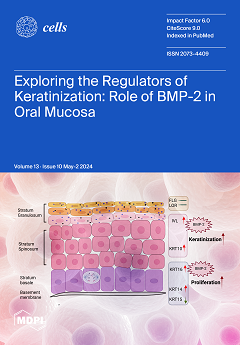Background: Chronic obstructive pulmonary disease (COPD) is characterized, at least in part, by autoimmunity through amplified T helper 1 and 17 (Th1 and Th17) immune responses. The loss of immune tolerance controlled by programmed death-ligand 1 (PD-L1) may contribute to this. Objectives: We studied the tolerogenic role of PD-L1
+ dendritic cells (DCs) and their subtypes in relation to specific T cell immunity and the clinical phenotypes of COPD. Methods: We used flow cytometry to analyze PD-L1 expression by the DCs and their subtypes in the peripheral blood mononuclear cells (PBMCs) from normal participants and those with COPD. T cell proliferation and the signature cytokines of T cell subtypes stimulated with elastin as autoantigens were measured using flow cytometry and enzyme-linked immunosorbent assays (ELISA), respectively. Measurement and main results: A total of 83 participants were enrolled (normal,
n = 29; COPD,
n = 54). A reduced PD-L1
+ conventional dendritic cell 1 (cDC1) ratio in the PBMCs of the patients with COPD was shown (13.7 ± 13.7%,
p = 0.03). The decrease in the PD-L1
+ cDC1 ratio was associated with a rapid decline in COPD (
p = 0.02) and correlated with the CD4
+ T cells (
r = −0.33,
p = 0.02). This is supported by the NCBI GEO database accession number GSE56766, the researchers of which found that the gene expressions of
PD-L1 and
CD4, but not
CD8 were negatively correlated from PBMC in COPD patients (r = −0.43,
p = 0.002). Functionally, the PD-L1 blockade enhanced CD4
+ T cell proliferation stimulated by CD3/elastin (31.2 ± 22.3%,
p = 0.04) and interleukin (IL)-17A production stimulated by both CD3 (156.3 ± 54.7,
p = 0.03) and CD3/elastin (148 ± 64.9,
p = 0.03) from the normal PBMCs. The PD-L1 blockade failed to increase IL-17A production in the cDC1-depleted PBMCs. By contrast, there was no significant change in interferon (IFN)-γ, IL-4, or IL-10 after the PD-L1 blockade. Again, these findings were supported by the NCBI GEO database accession number GSE56766, the researchers of which found that only the expression of
RORC, a master transcription factor driving the Th17 cells, was significantly negatively correlated to PD-L1 (r = −0.33,
p = 0.02). Conclusions: Circulating PD-L1
+ cDC1 was reduced in the patients with COPD, and the tolerogenic role was suppressed with susceptibility to self-antigens and linked to rapid decline caused by Th17-skewed chronic inflammation.
Full article






